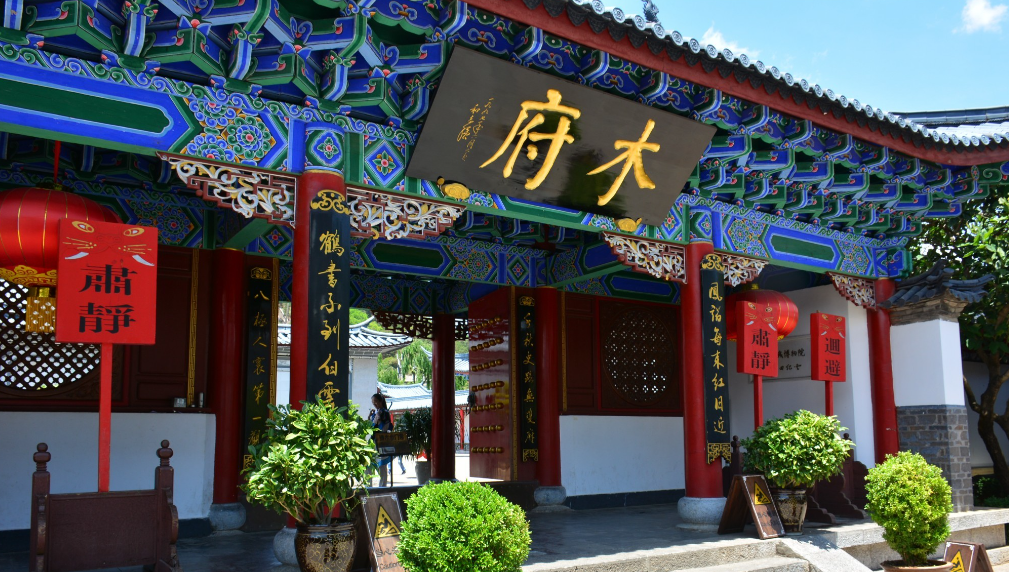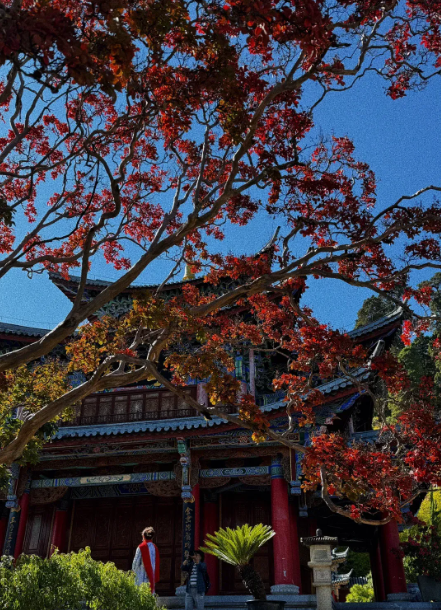Mufu Palace: Where Naxi Culture Meets Imperial Grandeur
Standing as the crown jewel of Lijiang Ancient Town, Mufu Palace whispers tales of power and cultural fusion through its vermilion pillars and azure-tiled roofs. For seven centuries, this sprawling complex served as the administrative heart and residential sanctuary for the influential Mu family, Tusi chieftains who ruled Lijiang under imperial mandate. Though ravaged by wars and earthquakes over time, its meticulous reconstruction reveals why locals say "Seeing Lijiang without visiting Mufu is like visiting a library without reading books."

Architectural Symphony of Three Cultures
The palace's layout pays homage to Ming Dynasty urban planning, with 108 rooms arranged along a central axis symbolizing the chieftain's connection to imperial power. Intricate wooden carvings on door panels showcase Bai craftsmanship, while the distinctive blue-glazed roof tiles - produced through a lost Naxi technique - create a rippling ocean effect when viewed from Lion Hill. Unlike Beijing's Forbidden City facing south, Mufu's eastward orientation follows Naxi Dongba religious principles, its three main halls ascending Lion Hill like a stone dragon climbing towards the sun.
Time Capsules Within the Palace Walls
Jade Sound Tower (Yuyin Lou): This three-story timber structure houses the Mu family's ceremonial drums and bronze bells. The unique "singing floor" made from 14 types of Yunnan pine resonates with musical tones when walked upon.
Light Jade Pavilion (Guangbi Lou): The chieftain's private library features ceiling murals depicting the Naxi creation epic "War Between Heaven and Earth," with original 15th-century pigments still visible in protected corners.
Three Purities Hall (Sanqing Dian): This Taoist temple within the complex displays rare Dongba scripture manuscripts on handmade hemp paper, some measuring 30 meters in length.

Practical Exploration Guide
Morning light reveals the palace's true colors - arrive by 9 AM to watch sunrise gild the carved phoenix patterns on the main gate. The ¥40 admission includes access to Lion Hill viewpoint, where panoramic views showcase how the palace's blue roofs contrast with civilian residences' grey tiles. Don't miss the "living water system" - stone channels carrying snowmelt from Jade Dragon Mountain still feed carp ponds and courtyard gardens as they did six centuries ago.
Essential Visitor Information
📌 Location: 49 Guangyuan Alley, Dayan Town
🚍 Transport: Bus 23 to Yulong County Hospital + 12min walk
⏰ Opening: 9AM-5:30PM daily (extended in summer)
🎟 Tickets: Adults ¥40 | Students/Seniors ¥20 | Free for children & military
Cultural Footprints in Modern Times
The palace gained global recognition through CCTV's historical drama "Mufu Fengyun," with several courtyards preserved exactly as shown in the series. Architecture enthusiasts should note the "three stones and five earths" construction method - local basalt, limestone and sandstone layers alternated with rammed earth mixtures containing rice paste and egg whites for earthquake resistance. This ancient technique proved crucial in surviving Lijiang's 1996 earthquake, which damaged over 60% of newer structures in the ancient town.
Mufu Palace FAQs
What's the best time to avoid crowds?
Late afternoons (3-5 PM) see fewer tour groups. Wednesdays tend to be quieter than weekends. The palace remains open during light rain, when the stone courtyards take on a beautiful sheen.
Are guided tours available?
Free English tours depart hourly from the main gate's bronze lion statues. Private guides specializing in Naxi architecture can be booked through Lijiang's cultural tourism bureau website.
Can we take photos inside?
Photography is permitted except in scripture preservation areas. The golden hour (4-5 PM) creates magical lighting on the eastern pavilions. Tripods require special permit from the administration office.
















